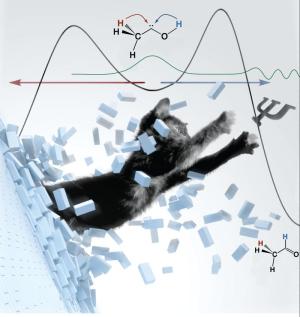摘要:来自德国乔治亚大学的化学家和一批德国合作者提出,首次发现化学反应的隧道控制机制,该机制能定向驱动化学反应,这一优点是传统理论不具备的。涵盖材料学和生化学的各个领域,隧道控制机制帮助科学家更好地理解和设计反应路径。
隧道控制的化学反应到底是怎么回事呢?简单的情况就是,在不提供任何额外热能的情况下,仅在氩气原子的氛围中,就可以实现化合物原子的重排、转化,比如说可以合成乙醛分子(Acetaldehyde)。因为在量子力学中,诸如原子、分子之类的粒子,可以通过隧道效应,穿越能垒而跑到另一边去。在传统的化学理论中,穿隧作用只是被简单地理解成一种反应速率的第二校正因子(Secondary correction factors),而从未被当作一种主要驱动力。
量子世界的神奇曾引起了人们广泛的兴趣和激烈的争议。奥地利物理学家薛定谔(Erwin Schrödinger)的理想实验——“薛定谔猫”(Schrödinger's Cat),表明了想运用量子力学的原理来解释日常观察到的事物,是多么地令人费解!
研究成果发表在最新一期的Science刊物上(DOI: 10.1126/science.1203761 )。他们从丙酮酸(Pyruvic acid)出发,通过真空高温分解反应(1200 K)合成出难以捉摸的分子——甲基羟基碳烯(H3C–C–OH),并通过极低温实验(11 K),在固态氩中捕获了这个分子。这也是该分子的首次成功分离。尽管反应分子需要越过的能垒高达28.0 kCal/mol,但通过穿隧作用,很容易实现了向乙醛分子的氢转移。虽然在捕获几小时后这个分子消失了,但这一发现已足够让人感到惊讶了,促使UGA的理论化学家Wesley Allen教授去实施大规模的、更精确的计算以解释这一现象。
生物探索推荐英文原文:
New Driving Force for Chemical Reactions

Pictured: Artistically rendered as Schrödinger's iconic cat escaping confinement by bursting through a brick wall, the molecule methylhydroxycarbene (center) is rearranged preferentially (blue arrow) to acetaldehyde (bottom right) by a process known as quantum mechanical tunneling under a large potential energy barrier. An alternative path (red arrow) producing vinyl alcohol is not operative, despite a significantly lower energy barrier. In their Science paper, Schreiner, Allen and co-workers combine experiment and theory to capture and characterize the elusive methylhydroxycarbene molecule in cryogenic matrices and reveal its unconventional chemical reactivity that is controlled by tunneling.
New research just published in the journal Science by a team of chemists at the University of Georgia and colleagues in Germany shows for the first time that a mechanism called tunneling control may drive chemical reactions in directions unexpected from traditional theories.
The finding has the potential to change how scientists understand and devise reactions in everything from materials science to biochemistry.
The discovery was a complete surprise and came following the first successful isolation of a long-elusive molecule called methylhydroxycarbene by the research team. While the team was pleased that it had "trapped" the prized compound in solid argon through an extremely low-temperature experiment, they were surprised when it vanished within a few hours. That prompted UGA theoretical chemistry professor Wesley Allen to conduct large scale, state-of-the-art computations to solve the mystery.
"What we found was that the change was being controlled by a process called quantum mechanical tunneling," said Allen, "and we found that tunneling can supersede the traditional chemical reactivity processes of kinetic and thermodynamic control. We weren't expecting this at all."
What had happened? Clearly, a chemical reaction had taken place, but only inert argon atoms surrounded the compound, and essentially no thermal energy was available to create new molecular arrangements. Moreover, said Allen, "the observed product of the reaction, acetaldehyde, is the least likely outcome among conceivable possibilities."
Other authors of the paper include Professor Peter Schreiner and his group members Hans Peter Reisenauer, David Ley and Dennis Gerbig of the Justus-Liebig University in Giessen, Germany. Graduate student Chia-Hua Wu at UGA undertook the theoretical work with Allen.
Quantum tunneling isn't new. It was first recognized as a physical process decades ago in early studies of radioactivity. In classical mechanics, molecular motions can be understood in terms of particles roaming on a potential energy surface. Energy barriers, visualized as mountain passes on the surface, separate one chemical compound from another.
For a chemical reaction to occur, a molecular system must have enough energy to "get over the top of the hill," or it will come back down and fail to react. In quantum mechanics, particles can get to the other side of the barrier by tunneling through it, a process that seemingly requires imaginary velocities. In chemistry, tunneling is generally understood to provide secondary correction factors for the rates of chemical reactions but not to provide the predominant driving force.
(The strange world of quantum mechanics has been subject to considerable interest and controversy over the last century, and Austrian physicist Erwin Schr?dinger's thought-experiment called "Schr?dinger's Cat" illustrates how perplexing it is to apply the rules and laws of quantum mechanics to everyday life.)
"We knew that the rate of a reaction can be significantly affected by quantum mechanical tunneling," said Allen. "It becomes especially important at low temperatures and for reactions involving light atoms. What we discovered here is that tunneling can dominate a reaction mechanism sufficiently to redirect the outcome away from traditional kinetic control. Tunneling can cause a reaction that does not have the lowest activation barriers to occur exclusively."
Allen suggests a vivid analogy between the behavior of methylhydroxycarbene and Schr?dinger's iconic cat.
"The cat cannot jump out of its box of deadly confinement because the walls are too high, so it conjures a Houdini-like escape by bursting through the thinnest wall," he said.
The fact that new ideas about tunneling came from the isolation of methylhydroxycarbene was the kind of serendipity that runs through the history of science. Schreiner and his team had snagged the elusive compound, and that was reason enough to celebrate, Allen said. But the surprising observation that it vanished within a few hours raised new questions that led to even more interesting scientific discoveries.
"The initiative to doggedly follow up on a 'lucky observation' was the key to success," said Allen. "Thus, a combination of persistent experimentation and exacting theoretical analysis on methylhydroxycarbene and its reactivity led to the concept I dubbed tunneling control, which may be characterized as `a type of nonclassical kinetic control wherein the decisive factor is not the lowest activation barrier'."
While the process was unearthed for the specific case of methylhydroxycarbene at extremely low temperatures, Allen said that tunneling control "can be a general phenomenon, especially if hydrogen transfer is involved, and such processes need not be restricted to cryogenic temperatures."
Allen's research was funded by the U.S. Department of Energy.







